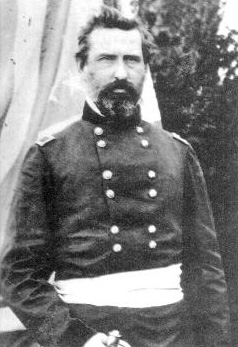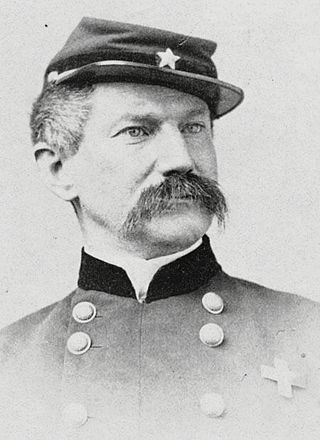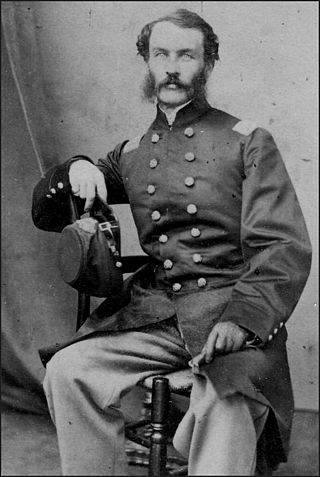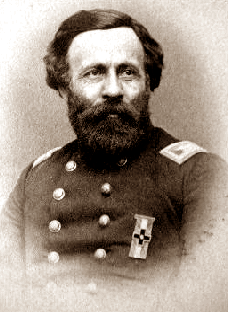Related Research Articles

The Army of the Potomac was the primary field army of the Union army in the Eastern Theater of the American Civil War. It was created in July 1861 shortly after the First Battle of Bull Run and was disbanded in June 1865 following the surrender of the Confederate Army of Northern Virginia in April.
The First Vermont Brigade, or "Old Brigade" was an infantry brigade in the Union Army of the Potomac during the American Civil War. It suffered the highest casualty count of any brigade in the history of the United States Army, with some 1,172 killed in action.

The VI Corps was a corps of the Union Army during the American Civil War.

Romeyn Beck Ayres was a Union Army general in the American Civil War.

Albion Parris Howe was an American officer who served as a Union general in the American Civil War. Howe's contentious relationships with superior officers in the Army of the Potomac eventually led to his being deprived of division command.

Cadmus Marcellus Wilcox was a career United States Army officer who served in the Mexican–American War and also was a Confederate general during the American Civil War.

William Thomas Harbaugh Brooks was a career military officer in the United States Army, serving as a major general during the American Civil War.

William Hays was a career officer in the United States Army, serving as a Union Army general during the American Civil War.

Ezra Ayers Carman was an officer in the Union Army during the American Civil War, commanding a New Jersey infantry regiment and (occasionally) a brigade.

Thomas Hewson Neill (1826–1885) was a native of Pennsylvania, became a general in the American Civil War, serving in the Army of the Potomac in some of its most important campaigns.

Henry Lawrence Eustis was an American civil engineer, college professor, and soldier who served as a general in the Union Army during the American Civil War.

Daniel Davidson Bidwell was a civic leader in Buffalo, New York, before the outbreak of the American Civil War. He enlisted early in the war and then was appointed colonel of a regiment of infantry. He was promoted to general in command of a brigade in early 1864, leading it until he was mortally wounded at the Battle of Cedar Creek.

Hiram Burnham was an officer in the Union Army who commanded a regiment and then a brigade in the Eastern Theater of the American Civil War. He was killed in battle while assaulting Confederate positions near Richmond, Virginia, during the Battle of Chaffin's Farm.
Henry J. Stainrook, occasionally spelled Steinrock, led a regiment of the Army of Virginia and the Army of the Potomac in the American Civil War. He briefly led a brigade at the Battle of Antietam. Stainrook was killed in the Battle of Chancellorsville.

Francis Huger (1837-1897), a son of Gen Benjamin Huger, served as a Confederate artilleryman in the American Civil War.
William A. Harn commanded a New York artillery battery in the American Civil War.
Adoniram Judson Clark commanded a New Jersey battery in the American Civil War.
Elijah Daniel Taft (1819-1915) was an artillery officer in the Union Army during the American Civil War.

Dunbar R. Ransom was a United States Army officer and veteran of the American Civil War. He is notable for having commanded Union Army artillery units throughout the conflict.
Battery A, 1st New Jersey Light Artillery was an artillery battery that served in the Union Army during the American Civil War.
References
- Jackson, William J., New Jerseyans in the Civil War: For Union and Liberty, Piscataway, NJ: Rutgers University Press, 2000. ISBN 0-8135-2775-9
- Parsons, Philip W., The Union Sixth Corps in the Chancellorsville Campaign, Jefferson, NC: McFarland, 2006. ISBN 0-7864-2521-0
- Toombs, Samuel, New Jersey Troops in the Gettysburg Campaign, from June 5 to July 31, 1863, Highstown, NJ: Longstreet House, 1988.
- ↑ New York Times, August 26, 1870.
- ↑ Jackson, p. 73.
- ↑ Jackson, p. 73.
- ↑ Toombs, p. 3.
- ↑ http://aotw.org/officers.php?officer_id=466 [ dead link ]
- ↑ Parsons, p. 50.
- ↑ Parsons, pp. 85, 95-96.
- ↑ Parsons, pp. 105, 107.
- ↑ Parsons, p. 127.
- ↑ http://www.njstatelib.org/NJ_Information/Searchable_Publications/civilwar/NJCWn1369.htm [ dead link ]
- ↑ Toombs, p. 289, 302-303.
- ↑ http://www.njstatelib.org/NJ_Information/Searchable_Publications/civilwar/NJCWn1369.html [ dead link ]
- ↑ New York Times, August 26, 1870.